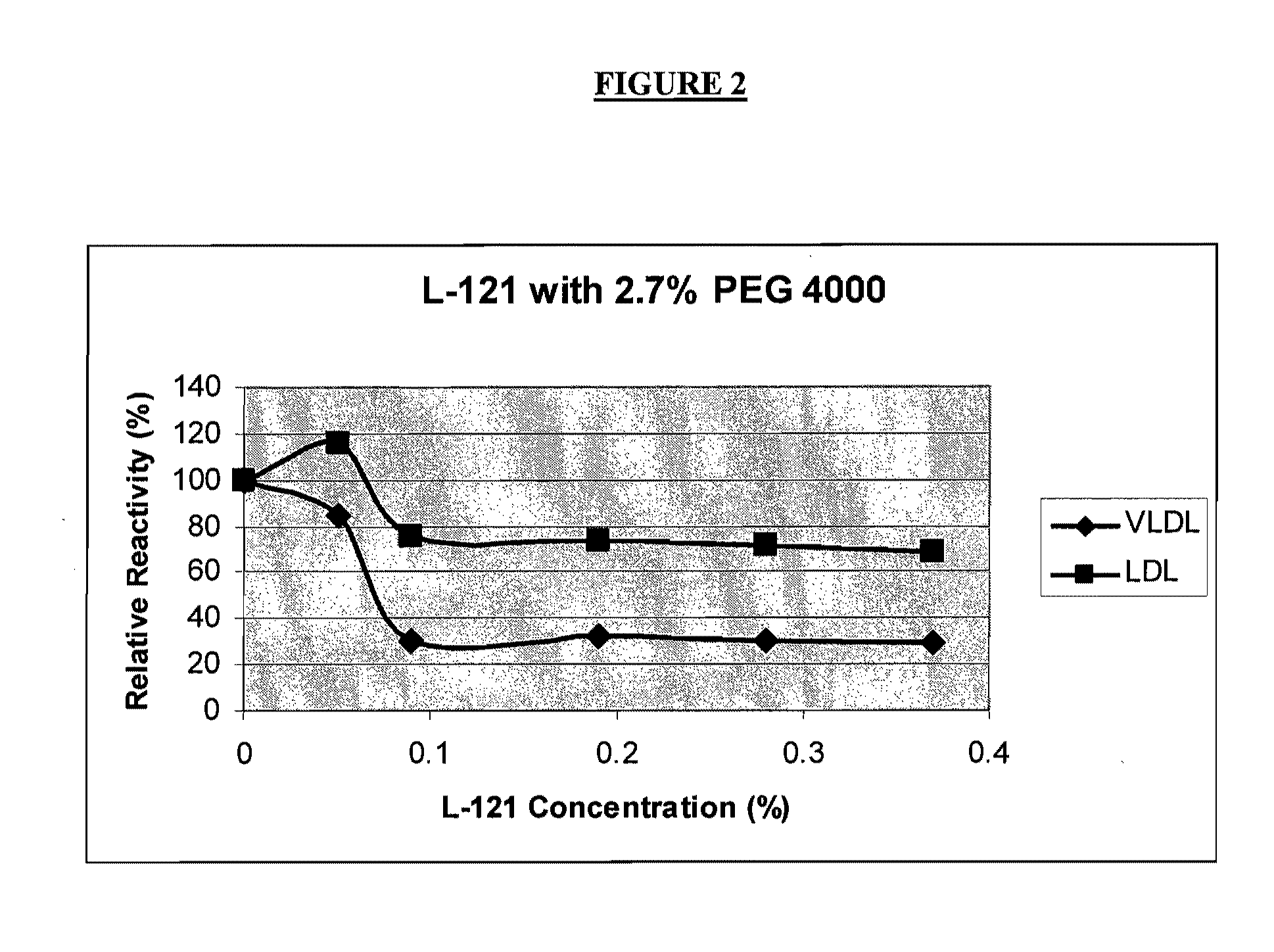Method for Measuring Lipoprotein-Specific Apolipoproteins
a lipoprotein and apolipoprotein technology, applied in the field of lipoprotein-specific apolipoprotein measurement, can solve the problems of poor chd prediction when dealing with an individual patient, lack of ease of routine assay implementation, and high cost of nmr technology
- Summary
- Abstract
- Description
- Claims
- Application Information
AI Technical Summary
Benefits of technology
Problems solved by technology
Method used
Image
Examples
example 1
Investigative Work Towards Development of a Method for Measuring LDL-Apo B Concentration or LDL Particle Concentration in a Biological Fluid
[0151]In order to identify conditions under which the anti-apo B antibody may bind preferentially to LDL-apo B over non-LDL-apo B, experiments were performed using lipoprotein fractions isolated from a serum pool. Ultracentrifugation was used to isolate chylomicrons, if present, and VLDL fractions (d1.006 g / ml). Chylomicrons contribute relatively little apo B, especially in the fasting state, and HDL particles do not contain apo B. Therefore, these fractions above may be characterized as, respectively, “VLDL fraction” and “LDL fraction” for the purpose of apo B analysis.
[0152]The ability of each fraction to interact with anti-apo B antibody was evaluated using the Cobas Fara chemical analyzer. In a typical procedure, each fraction (6 μL) was mixed with 285 μL of Reagent R1. The composition of Reagent R1 was varied to investigate its influence on...
example 2
Method for Measuring LDL-Apo B Concentration or LDL Particle Concentration in a Biological Fluid
[0160]Based on the optimization experiments described in Example 1, three Reagent R1 formulations were selected for further study.
Reagent R1
[0161]Formulation 1: Pluronic® F-68 (0.5%); PEG 4000 (2.5%); PBS buffer, pH 7.4.[0162]Formulation 2: Brij® 700 (0.005%); PEG 8000 (3%); PBS buffer, pH 7.4[0163]Formulation 3: Pluronic® F-127 (0.01%); PEG 8000 (5%), PBS Buffer, pH 7.4
[0164]In a typical experiment, the assay was set up on a Cobas Fara analyzer using 6 μL sample of biological fluid, 285 μL of Reagent R1 (selected from one of the three formulations listed above), and 95 μL of Reagent R2. Reagent R2 consisted of a 1 part of apo B antiserum (Midland Bioproducts, Boone Iowa) diluted in 7.5 parts of 50 mM Tris base, pH 8.0. The biological sample was added to Reagent R1 and incubated at about 37° C. for about 5 minutes. After the “blank” absorbance measurement, Reagent R2 was added. About thre...
example 3
Assay Performance
[0168]Studies were performed to determine within-run and total precision, limit of detection, limit of quantitation, and linearity. Institutional review board (IRB) approval was obtained, and sera were obtained from volunteers who provided informed consent. Enough serum was available to separate VLDL and LDL by ultracentrifugation in 19 subjects. The LDL-apoB assay was calibrated with the WHO / IFCC SP3-08 reference material. This provided a reasonably accurate standard; however, the reference material is a stabilized serum pool that contains some VLDL.
[0169]Data were collected on the Roche Cobas Fara analyzer as previously described, with the exception that 0.5 g / L dextran sulfate and 2 mM magnesium chloride were added to the R1 formulation, along with 0.6% Pluronic F-68. Within-run imprecision, assessed with three levels of QC material (52, 107, and 124 mg / dL), was 3.4%, 3.1, and 1.8%, respectively. Total imprecision, determined by measuring the same three levels of...
PUM
| Property | Measurement | Unit |
|---|---|---|
| temperature T2 | aaaaa | aaaaa |
| temperature T1 | aaaaa | aaaaa |
| diameter | aaaaa | aaaaa |
Abstract
Description
Claims
Application Information
 Login to View More
Login to View More - R&D
- Intellectual Property
- Life Sciences
- Materials
- Tech Scout
- Unparalleled Data Quality
- Higher Quality Content
- 60% Fewer Hallucinations
Browse by: Latest US Patents, China's latest patents, Technical Efficacy Thesaurus, Application Domain, Technology Topic, Popular Technical Reports.
© 2025 PatSnap. All rights reserved.Legal|Privacy policy|Modern Slavery Act Transparency Statement|Sitemap|About US| Contact US: help@patsnap.com



